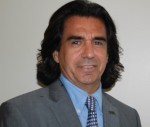 University Transportation Centers (UTC) are located at 75 institutions of higher learning across the U.S. Established in 1987 under the USDOT Surface Transportation and Uniform Relocation Assistance Act, their purpose is to facilitate transportation research and technology transfer.
University Transportation Centers (UTC) are located at 75 institutions of higher learning across the U.S. Established in 1987 under the USDOT Surface Transportation and Uniform Relocation Assistance Act, their purpose is to facilitate transportation research and technology transfer.
Dr. Atorod Azizinamini, chair of Florida International University’s(FIU) Department of Civil and Environmental Engineering, is also director of FIU’s Accelerated Bridge Construction (ABC) UTC. Its focus is on advancing ABC technologies, which include innovative planning, design, materials, and construction methods to reduce interruption to traffi c by minimizing onsite construction activities.Bridge components constructed using ABC technologyare assembled offsite, then transported to the job site for assembly. However, ABC bridges have more joints, which can adversely affect service life. “The challenge is to not compromise service life when building with ABC,” says Azizinamini.
“The USDOT anticipates that within the next 15-20 years, bridge construction using ABC will be widespread,” says Azizinamini. “Therefore, FIU’s UTC is preparing students to plan for this important advancement in bridge construction technology.”
In addition to directing the work of the UTC, Azizinamini is the principal investigator for several research projects under contract with FDOT. Recently, he and his research team sought to develop new non-destructive testing (NDT) techniques that bridge maintenance engineers can us e when inspecting posttensioned steel strands in segmental concrete bridges. Currently, only visual methods are used for inspections. While bridges constructed using posttensioned strands have many advantages, their cables and anchors are vulnerable to corrosion, exacerbated by Florida’s hot, humid, and often salty environment. Further, bridge tendons are typically embedded inconcrete, making visual inspection difficult.
As part of a recently completed project, Azizinamini and his research team conducted an in-depth review of possible techniques to inspect bridge tendons and developed a guide identifying inspection alternatives. The National Cooperative Highway Research Program (NCHRP) is using the research fi ndings to develop inspection guidelines to assist bridge owners in selecting the most appropriate NDT method or combination of methods for assessing the condition of post-tensioning systems common in U.S. bridges.
In two related ongoing projects, Azizinamini and his research team are conducting NDT of segmental concrete bridges to evaluate the merits of various NDT technologies that could be used during bridge inspections to detect and assess corrosion of internal tendons and cable stays.
Florida has the nation’s largest inventory of twin steel box girder bridges, whose components are often referred to as fracture critical, a family of bridges engineers believe will collapse if an important tension member breaks. These types of bridges are built over long waterways, making inspections difficult and expensive. Azizinamini and his research team are studying the feasibility of reducing the number of biannual inspections of fracture critical bridges based on advanced technology and analysis.
In another project, he and his research team are developing a set of recommendations, procedures, and instructions to address analysis, design, and construction issues related to cross frames and diaphragms of steel I-girder bridges, which could lead to uniform structural design of cross frames.
Azizinamini looks forward to helping FDOT get the most out of existing bridges and providing engineers and designers with best principles for designing bridges for a long service life.
“Because of its investment in research, FDOT is at the forefront of technology,” says Azizinamini. “I want to help ensure that the bridges we build today will perform better and last longer than those currently in service, and that we save money and resources for generations to come.”
SOURCE : FDOT RESEARCH SHOWCASE Winter2014

